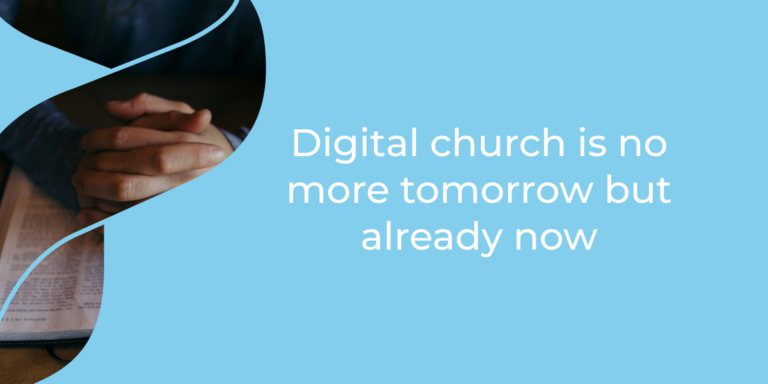In today’s world, digital technology is gradually influencing every aspect of our lives, including the church. “Digital church” is no longer an idea for the future, but rather a reality that exists today.
The increased popularity of digital platforms for spiritual communication, prayer, and pastoral help demonstrates that the church is successfully adapting to the demands of the times.
What Is a Digital Church?
A digital church is a way of organizing religious activities and life via the Internet. It connects believers and spiritual leaders using online platforms, social media, special programs, and websites. Such a church has no physical bounds; you can participate in worship, group prayers, or spiritual discourse regardless of where you are.
The digital church employs cutting-edge technologies for spiritual enrichment, support, and faith formation in the context of ongoing connection with the technological world.
Digital Pastoral Care

Digital pastoral care is one of the primary tasks of the digital church. Communication with spiritual leaders has become more accessible thanks to platforms that allow conversations through video calls, social networks, or specialized websites.
A good example is PrayForMe — a space where religious leaders can offer their services, providing spiritual advice and support to believers all over the world. This system allows you to quickly get answers to spiritual questions, no matter where you are.
Prayer on Social Networks
Social networks have long been used to exchange information and communicate, but now they also play a role in the spiritual lives of many people. Prayer on social media allows you to connect with other believers, regardless of physical distance.
People can pray together, share religious ideas, and support one another. For example, you can set up prayer groups on Facebook or Telegram where everyone can contribute their prayer or request and others can support it with their faith.
This method also allows you to participate in worship and prayer even if you are unable to physically attend church, due to illness or travel. Social networks have arrived as a new tool for promoting faith and sharing spiritual information.
Spiritual Growth in The Digital Age
Spiritual growth has always been a top priority for believers. But how does it work in the context of digital reality? The digital church provides a wide range of tools for improving spiritual life. Online sermons, seminars, Bible readings, and interactive conversations — all of this has become accessible thanks to the internet.
Online platforms offer an opportunity to learn and improve one’s spiritual understanding by providing easy access to content that can be viewed at any time. Furthermore, it provides a convenient option for individuals who live in remote places or are unable to attend regular church services.
Faith in the Digital Age

The arrival of digital technologies has changed our understanding of how we understand faith. Today, many people turn to the Internet for spiritual support and guidance. Believers have access to a variety of resources, including online libraries of religious literature, video classes, and podcasts about faith and life in religion.
However, it is crucial to find a balance between online faith and actual spiritual life. Digital tools must become a complement to traditional spiritual practice, rather than a replacement for personal communication with God.
Faith and Prayer in Social Networks
Social media has opened up fresh possibilities for religious expression. Everyone is welcome to share their opinions on faith, pray, or find assistance in the forum comments. There are advantages: social networks permit rapid dissemination of religious content and the opportunity to engage young people in spiritual life.
However, there are certain risks. A lack of personal communication may make prayer meaningless, while a superficial attitude toward faith can become commonplace. It is vital to remember that prayer and faith require not only words but also true concentration, which is not always possible in the context of online communication.
Tools for Prayer
Today, there are numerous tools that facilitate prayer in the digital space. These might be specific apps that send prayer reminders, provide prayer texts, or allow users to keep prayer journals. Some platforms let you record prayer requests and then share them with other users who join you in prayer.
Apps such as “Daily Prayer” and “Echo Prayer” help manage prayer lives by simplifying the prayer process and reminding users of essential spiritual activities. These tools might also be helpful to those who just started their spiritual journey and require support.
The Advantages of A Digital Church
- Accessibility: One of the most significant advantages of a digital church is its accessibility. Believers can participate in worship or receive spiritual support regardless of their location or physical ability.
- A wide selection of content: The internet provides a multitude of spiritual growth resources, including lectures, sermons, Bible studies, and prayer groups. All of this may be found with a few clicks.
- Interactivity: Social networks allow believers to engage with one another, discuss spiritual ideas, and pray together. It also encourages the creation of online communities where people support each other in their faith.
- Globality: The digital church removes boundaries. You can contact a spiritual leader in another country, join an international community, or attend religious activities presented far away from you.
- Innovative prayer tools: Digital applications make prayer more organized and accessible, particularly for those who live active lives and require discipline in their spiritual practice.
Disadvantages of A Digital Church

- Lack of physical contact: Despite all of the benefits of the digital church, many people believe that online contact cannot replace physical presence at church and shared religious rituals.
- The risk of a superficial attitude: Since digital content is often consumed quickly, there is a risk that faith may become something superficial. Prayer or spiritual practices can become a formality when the user simply scrolls through social media feeds.
- Dependence on technology: The digital church depends on technology, and if technical issues arise, it can hinder interaction with faith.
- Insufficient depth of contact: Some believers think that Internet communication does not provide the same level of interaction with clergy as a personal meeting.
Conclusion
The digital church is already a reality, and it plays an increasingly significant role in people’s spiritual lives. The usage of digital technologies for pastoral care, prayer, and faith interaction offers new opportunities for the growth and support of believers in the modern world.
Although there are certain drawbacks, the digital church has significant advantages that make it an important part of the religious life of many people. The PrayForMe platform is a vivid example of how digital tools can support spiritual ministry and help spiritual leaders expand their audience and assist people.









